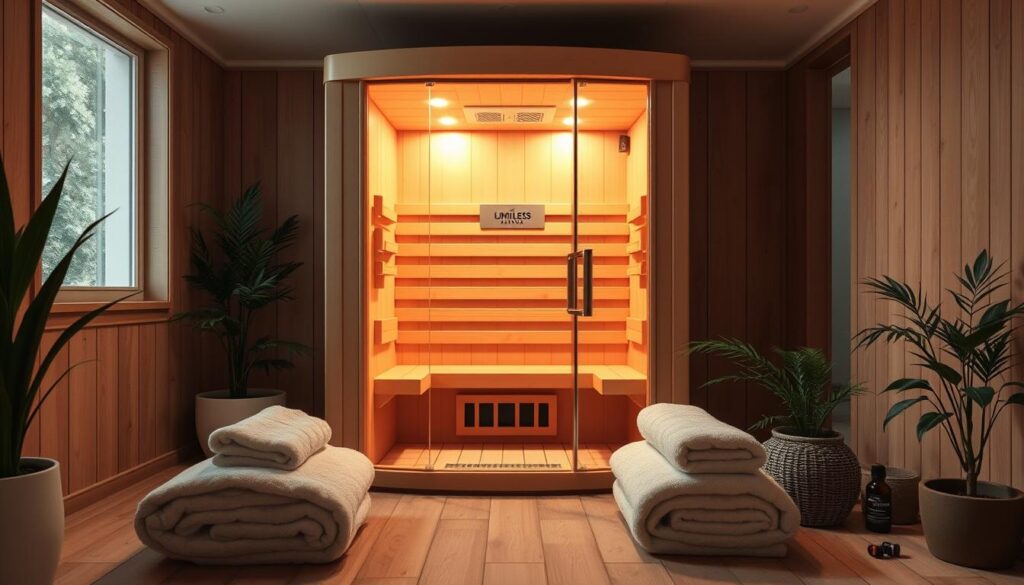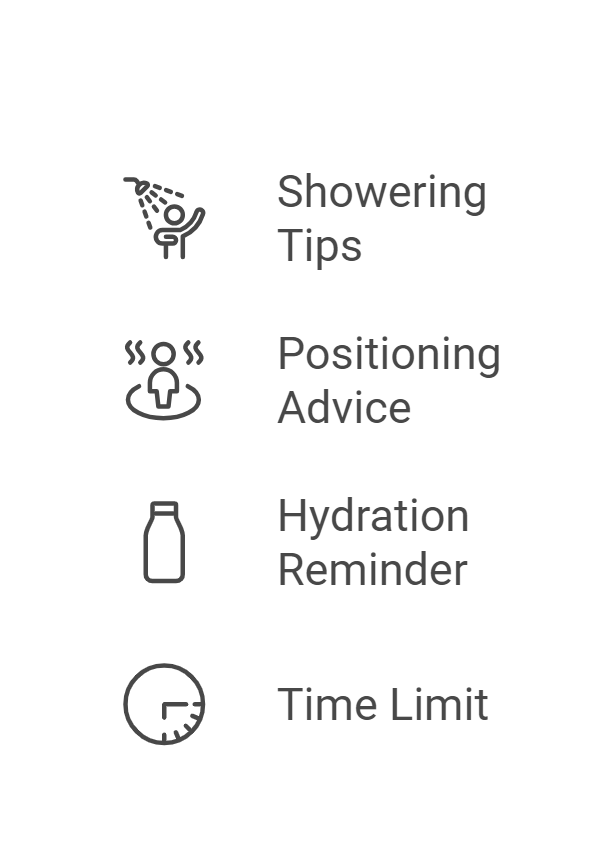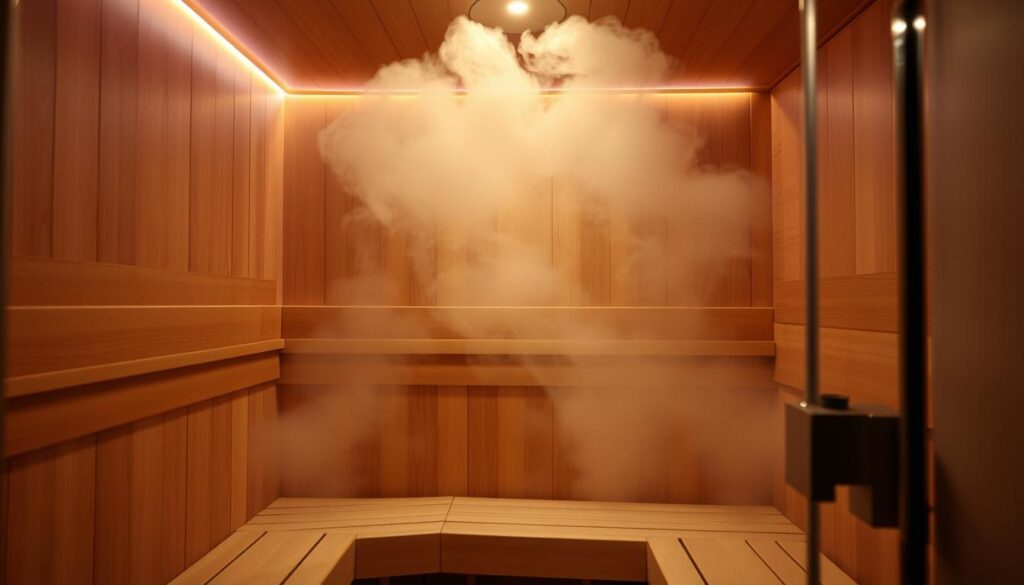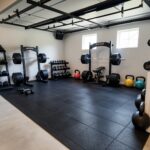Are you getting the most out of your infrared home sauna? This powerful tool offers many health benefits. But, many users might not be using it to its full potential. Let’s find out how to make the most of your sauna sessions for better health.
Infrared saunas are popular for their deep, penetrating heat. They work at lower temperatures than traditional saunas. This heat goes straight to your body, not just the air.
This unique heat therapy can improve sleep, relieve muscles, and help with chronic fatigue. To get the most out of your infrared home sauna, it’s important to know how to use it right. From how long to stay in to staying hydrated, every detail matters. Let’s explore the key factors to enhance your sauna experience and boost your wellness at home.
Table of Contents
Key Takeaways
- Infrared saunas operate at lower temperatures, focusing on direct body heating
- Proper hydration before, during, and after sessions is crucial
- Gradual increase in session duration from 5 to 20 minutes is recommended
- Frequency of use can range from 3-4 times weekly to daily for some individuals
- Positioning in the sauna affects the absorption of infrared light and heat
- Combining sauna use with relaxation techniques enhances overall benefits
- Post-sauna cold showers help close pores and prevent toxin reabsorption
Understanding Infrared Home Saunas
Infrared saunas are becoming more popular for their unique heat therapy. They offer many health benefits, making them a great addition to homes.
What is an infrared sauna?
An infrared sauna uses light waves to heat your body directly. This is different from traditional saunas that heat the air. They work at lower temperatures, between 135°F to 158°F, making them more comfortable.
This gentle heat allows for longer sessions. It also means you can enjoy more health benefits.
How infrared saunas differ from traditional saunas
The main difference is in how they heat. Traditional saunas heat the air around you. Infrared saunas use light to warm your body directly.
This direct heat penetrates deeper. It allows for more intense sweating at lower temperatures.
Health benefits of infrared sauna therapy
Infrared Heat Therapy has many potential health benefits. Research has looked into its effects on high blood pressure, heart failure, and type 2 diabetes, and early results are promising..
| Benefit | Description |
|---|---|
| Weight Loss | A 30-minute session can burn up to 600 calories |
| Skin Health | May help with acne, psoriasis, and eczema |
| Detoxification | Promotes sweating, aiding in toxin removal |
| Relaxation | Helps reduce stress and promote well-being |
Experts suggest using an infrared sauna 2-3 times a week. It’s important to stay hydrated and start with short sessions. Gradually increase the time as your body gets used to the heat. With proper use, an infrared sauna can greatly improve your health and wellness.
Choosing the Right Location for Your Infrared Home Sauna
Finding the best spot for your infrared sauna is key to enjoying its benefits. Home saunas can turn any area into a wellness haven. But, planning carefully is essential.
Considering Size and Space Requirements
Size is important when picking a spot for your infrared sauna. Think about how many people will use it to ensure comfort. JNH saunas are light, making them easy to move to upper floors without extra shipping costs.
- 1-Person Saunas: Ideal for solo relaxation and minimal space
- 2-Person Saunas: Perfect for couples
- 4-Person Saunas: Great for families or sauna parties
Ensuring Proper Ventilation
Good ventilation is crucial for a safe and enjoyable sauna experience. Garages often have natural air flow, which can help. But, avoid damp places to stop mold and keep the sauna working well.
Electrical Considerations
The power needs of your infrared sauna depend on its size. Bigger saunas need more power to heat up right. Make sure the area has enough electricity for the best performance.
Privacy and Comfort Factors
Make your sauna area as relaxing as possible. Bathrooms, basements, or special wellness rooms are good choices. Outdoor spots like patios or decks can also work, but remember JNH saunas are for indoor use only.
| Location | Advantages | Considerations |
|---|---|---|
| Bathroom | Easy access to water, privacy | May require ventilation upgrades |
| Basement | Ample space, quiet | Check for humidity issues |
| Garage | Spacious, natural ventilation | Insulation may be needed |
| Dedicated Room | Customizable, private | May require renovation |
By thinking about these points, you can find the ideal spot for your infrared home sauna. This will ensure a relaxing and beneficial experience for many years.
Preparing for Your Infrared Sauna Session
Get ready to boost your At-Home Wellness routine with Infrared Heat Therapy. Start by drinking 16 to 20 ounces of water before your sauna session. This helps replace the fluids you’ll lose – up to 2% during a typical session.
Remove makeup and lotions to allow your skin to breathe freely. Wear loose, comfortable clothing or go nude to maximize skin exposure. This enhances the benefits of the infrared rays penetrating your soft tissues.

Consider light exercise or stretching before entering the sauna. This improves blood flow and enhances the effects of the heat therapy. Remember, Far Infrared saunas are designed to relax your body and muscles.
For beginners, start with 10 to 15-minute sessions. Gradually increase to the recommended 20-30 minutes as your body adjusts. Aim for 3-4 sessions per week to maximize health benefits.
Position yourself directly in front of the heaters for optimal exposure. Unlike traditional saunas, don’t pour water on the heaters in Far Infrared saunas. Adopt a relaxed mindset to fully enjoy your At-Home Wellness experience and reap the most from your Infrared Heat Therapy session.
Optimal Duration and Frequency of Sauna Use
To get the most from infrared saunas, knowing the best session length and frequency is key. Let’s dive into how to make your sauna time as beneficial as possible for your health.
Recommended Session Length for Beginners
For newcomers, start with short sessions. Begin with 5 to 10 minutes at 105-110°F. This helps your body adjust to the heat slowly. You might start sweating after 8-10 minutes, showing your body’s heat response.
Gradually Increasing Session Duration
As you get used to it, increase your time. Start with 20-30 minutes and then go up to 25-45 minutes. Always listen to your body and leave if you feel too hot. Infrared saunas heat up at 2-4°F per minute, so adjust your time as needed.
Ideal Frequency for Maximum Health Benefits
For the best results, use your infrared sauna 3-4 times a week. Some people prefer daily use, which is safe with enough water. Regular use helps improve heart health, lowers stroke risk, and boosts detox.
| Frequency | Duration | Benefits |
|---|---|---|
| 3-4 times/week | 20-45 minutes | Improved cardiovascular health, stress reduction |
| Daily | 20-30 minutes | Enhanced detoxification, weight management support |
| 2 times/day | 20-30 minutes each | Targeted therapy for specific health goals |
Don’t forget to drink plenty of water, aiming for half your body weight in ounces daily. Wait 1-2 hours after eating before your sauna. With regular use, you’ll see the full benefits of infrared sauna therapy for your health and wellness.
Maximizing Skin Exposure for Enhanced Benefits
Infrared Heat Therapy works best when your skin is directly exposed to the heat. To get the most out of your infrared home sauna sessions, consider going nude or wearing minimal clothing. This approach allows the infrared waves to penetrate your skin effectively, maximizing the benefits of detoxifying infrared home saunas.
Studies show that regular use of an infrared home sauna can significantly improve skin health. These saunas may increase collagen and elastin production, contributing to a more youthful appearance. Many users report reduced fine lines, improved skin tone, and decreased inflammation with consistent infrared sauna sessions.
When deciding what to wear in your infrared home sauna, opt for breathable fabrics. Natural fibers like cotton, linen, and bamboo work well. High-quality synthetic materials with moisture-wicking properties are also suitable. Avoid fabrics like wool, silk, and rayon, which may be uncomfortable in high heat.
“For maximum benefit in a sauna, maintaining skin exposure to heat is crucial.”
To optimize your sauna experience, try these tips:

Remember, the average person loses about a pint of sweat during a brief sauna session. Be sure to drink 2-4 cool glasses of water afterward to rehydrate. For those new to Infrared Heat Therapy, start with shorter sessions and gradually increase duration as you become more comfortable.
| Frequency | Benefits |
|---|---|
| 1-2 days/week | Some improvement |
| 3-4+ days/week | Maximum benefits |
By maximizing skin exposure and following these guidelines, you’ll enhance the detoxifying effects, improve circulation, and optimize the therapeutic impact of infrared heat on your muscles and joints.
Hydration and Nutrition for Sauna Sessions
Drinking enough water and eating right are important for getting the most out of your sauna. We’ll look at how to feed your body before, during, and after your infrared sauna time.
Pre-sauna Hydration Tips
Drinking at least 16 ounces of water before your session helps prepare your body for sweating and prevents dehydration.
Maintaining Hydration During Sauna Use
Drink water while you’re in the sauna. For longer times, an electrolyte drink can help replace lost minerals.
Post-sauna Rehydration Strategies
It’s very important to drink water after your sauna. Watermelon, with its high water content, is a great choice. Coconut water is also good, as it has lots of electrolytes.
Nutritional Considerations for Sauna Users
Eating well helps your body get rid of toxins when you use the sauna. Here are some foods to eat after your sauna:
| Food | Benefits |
|---|---|
| Oranges | Rich in Vitamin C and potassium |
| Cucumbers | High water content, low calories |
| Berries | Packed with antioxidants |
| Leafy greens | Essential nutrients |
| Grilled chicken/tofu | Lean protein for muscle repair |

Being well-hydrated and eating well makes your sauna routine better. It helps with weight loss and keeps you healthy.
Incorporating Exercise and Stretching with Infrared Sauna Use
Adding exercise and stretching to your infrared sauna routine can enhance your wellness at home. The infrared heat makes your muscles soft and ready for stretching. This mix can enhance flexibility, blood flow, and overall health.
Here are some easy stretches to try in your infrared sauna:
- Low back stretch
- Neck and shoulder rolls
- Spinal twist
- Hamstring stretch
- Posture-improving stretch
Hold each stretch for 20-30 seconds. Breathe deeply and stretch gently. This can help you move better and fight off age-related stiffness.
If you have enough room, some infrared saunas at home are big enough for yoga or stretching. The Golden Designs 4 Person Full Spectrum model is great for this.
Using an infrared sauna with exercise boosts both activities. It can improve blood flow, muscle recovery, and calorie burn. The sauna’s relaxing effects also lower stress, making workouts more fun.
“The combination of stretching and infrared sauna use can significantly improve core temperature, circulation, and overall wellness.”
Always listen to your body and drink water when exercising in your infrared sauna. Begin with gentle moves and slowly get more intense as you get used to the heat. With regular practice, you’ll get the most out of your infrared sauna sessions.
Proper Maintenance and Cleaning of Your Infrared Home Sauna
Keeping your infrared home sauna clean is important for enjoying its benefits for years. The good news is that these saunas need little upkeep because of their dry heat.
Regular Cleaning Routines
Wipe down benches with a damp cloth after each use to remove sweat and dirt. For a deeper clean, mix water and baking soda every two weeks. Vacuum the floor monthly and mop as needed. Always use pure water to avoid mineral buildup.
Maintaining Infrared Heaters
Infrared heaters are the heart of your sauna. Gently wipe them with a damp cloth when cool. Make sure they’re dry before use. These heaters naturally purify the air, so they don’t need frequent cleaning. Regular checks will keep them efficient.
Addressing Common Maintenance Issues
Prevent stains by using towels on benches and under feet. If stains occur, light sanding can often remove them. Avoid varnishing or painting the wood as it hinders natural breathing. For a fresh scent, try natural ingredients like lemon or lavender. Remember, food and drinks are off-limits in your sauna to prevent stubborn stains.
- Disinfect surfaces with 70% alcohol solution
- Clean rubber mats regularly if used
- Sand certain areas annually for a fresh look
- Check electrical connections periodically
By following these simple maintenance tips, you’ll ensure your infrared home sauna remains a clean, efficient, and enjoyable space for relaxation and health benefits.
Conclusion
Getting an infrared home sauna can really change your at-home wellness game. The science behind it is strong. A 2018 study looked at over 3,800 people and found both infrared and traditional saunas have benefits.
Using an infrared sauna often can do a lot for your health. It might even lower your risk of heart problems and high blood pressure. One study found it could help with depression too. This shows how infrared home saunas can boost your well-being.
To get the most out of your infrared home sauna, be consistent. Start with short sessions and slowly increase them. Always drink water, listen to your body, and keep your sauna clean. Doing this makes your sauna more than just a piece of furniture. It becomes a place for you to relax and feel better.







